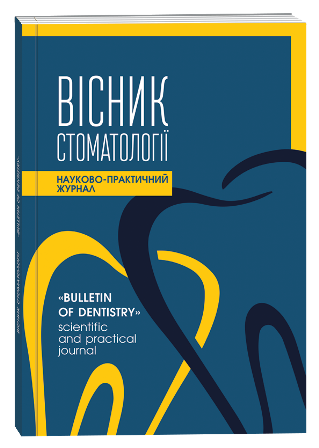THE EFFECTIVENESS OF THE USE OF ENAMEL MATRIX PROTEINS AND THE A-PRF TECHNIQUE IN THE COMPLEX TREATMENT OF PATIENTS WITH GENERALIZED PERIODONTITIS II, II-III STAGES
DOI:
https://doi.org/10.35220/2078-8916-2024-51-1.6Keywords:
generalized periodontitis, periodontal pockets, loss of epithelial attachment, enamel matrix proteins, A-PRF.Abstract
Aim. Increasing the effectiveness of the complex treatment of patients with generalized periodontitis II, II-III stages by using enamel matrix proteins and the A-PRF technique. Materials and methods. 65 people aged 34-59 years with a diagnosis of generalized periodontitis II and II-III degrees were selected for the study. In group I (14 people), a flap operation was performed in the form of a coronally displaced flap; in group II (16 people) coronal displacement of the flap was performed in combination with enamel matrix proteins; in the III group (17 people) – coronal displacement of the flap using A-PRF technology; in the IV group (18 people) – coronal displacement of the flap using A-PRF technology and enamel matrix proteins. Observation periods: before treatment, 10 days and after 3, 6 months. The depth of periodontal pockets (PP), levels of loss of epithelial attachment and gingival recession (classification according to P.D. Miller) were determined. Using the bleeding index (Muhlemann, 1971 in the modification of Cowell I., 1975) the bleeding of the gums was assessed. The data obtained during the examination of the patients were recorded in the periodontological charts. Results. Among the proposed methods of treatment, the additional use of enamel matrix proteins (EMP) showed a statistically significant difference in increasing the level of clinical attachment and decreasing the depth of periodontal pockets in favor of CAF +A-PRF + EMP (p≤0.05). In particular, in the IV group, the average value of PP depth decreased by 2.59 mm after 6 months. In groups I, II and III, this indicator was 1.29 mm, 2.0 mm and 1.8 mm respectively. The average value of loss of epithelial attachment decreased in patients of all groups during 6 months of observation: in group I by 18.8 %, group II by 26.4 %, group III by 24.4 %, group IV by 34.4 %. The average value of the PMA index of the patients was 55.1 %. In patients of group I, the value of the PMA index decreased by 2.0 times over 6 months, in group II – by 2.7 times, in group III – by 2.6 times, and in group IV, the intensity of gingival inflammation decreased by 3.1 times The average value of the bleeding index decreased in all groups with a noticeable advantage of using a combination of EMP and PRF. Thus, in patients of the I group, the average value of the index decreased by 2.1 times over the course of 6 months, in the II group – by 2.6 times, in the III group – by 2.5 times, and in the IV group – by 3.0 times. Conclusions. Carrying out a flap operation with the additional use of A-PRF and the preparation of enamel matrix proteins "Emdogain" was associated with the most pronounced results of stabilization of the inflammatory process and regeneration in periodontal tissues.
References
Agrawal, A.A. (2017). Evolution, Current Status and Advances in Application of Platelet Concentrate in Periodontics and Implantology. World J. Clin. Cases, 5, 159–171.
Barbon, S., Stocco, E., Macchi, V., Contran, M., Grandi, F., Borean, A. & et al. (2019). Platelet-Rich Fibrin Scaffolds for Cartilage and Tendon Regenerative Medicine: From Bench to Bedside. Int. J. Mol. Sci., 20, 1701.
Deng, Y., Liang, Y., & Liu, X. (2022). Biomaterials for Periodontal Regeneration. Dent Clin North Am., 66(4), 659-672. doi: 10.1016/j.cden.2022.05.011. Epub 2022 Sep 11.
Fan, L., & Wu, D. (2023). Enamel Matrix Derivatives for Periodontal Regeneration: Recent Developments and Future Perspectives. J Healthc Eng. 2023, 24, 9867516. doi: 10.1155/2023/9867516.
Ilkiv, M.M., Rozhko, M.M., & Hereliuk, V.I. (2020). Impact of Periodontal Pocket Depth on the Efficiency of Surgical Treatment of Generalized Periodontitis. Halyts. likar. visnyk., 27 (3), 26-29.
Liu, J., Ruan, J., Weir, M.D., Ren, K, & Schneider A. (2019). Periodontal Bone-Ligament-Cementum Regenerationvia Scaffolds and Stem Cells. Cells., 4, 8(6),537. doi: 10.3390/cells8060537
Miron, R.J., Choukroun, J., & Ghanaati, S. (2019). Reply from authors: RE: Optimized platelet-rich fibrin with the low-speed concept: Growth factor release, biocompatibility, and cellular response: Necessity for standardization of relative centrifugal force values in studies on platelet-rich fibrin. J Periodontol., 90(2), 122-125 doi: 10.1002/JPER.18-0329.
Miron, R.J., Chai, J., Fujioka-Kobayashi, M., Sculean, A., & Zhang, Y. (2020). Evaluation of 24 Protocols for the Production of Platelet-Rich Fibrin. BMC Oral Health, 20, 310.
Rojas, M.A., Marini, L., Pilloni, A., & Sahrmann, P. (2019). Early wound healing outcomes after regenerative periodontal surgery with enamel matrix derivatives or guided tissue regeneration: a systematic review. BMC Oral Health., 7, 19(1), 76. doi: 10.1186/ s12903-019-0766-9.
Saini, K., Chopra, P., & Sheokand, V. (2020). Journey of Platelet Concentrates: A Review. Biomed. Pharmacol. J., 13, 185–191
Voznyi, O.V., Hermanchuk, S.M., Struk, V.I., Bida, V.I., & Pohorila, AV. (2019). Stan i perspektyvy rozvytku stomatolohichnoi dopomohy naselenniu Ukrainy. Aktualni pytannia farmatsevtychnoi i medychnoi nauky ta praktyky, 12(2), 228–34.









